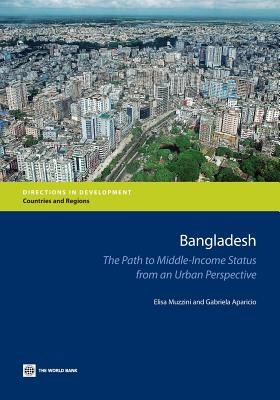
- We will send in 10–14 business days.
- Author: Elisa Muzzini
- Publisher: World Bank Publications
- ISBN-10: 0821398598
- ISBN-13: 9780821398593
- Format: 17.8 x 25.4 x 0.8 cm, softcover
- Language: English
- SAVE -10% with code: EXTRA
Reviews
Description
By 2021, the 50th anniversary of its independence, Bangladesh seeks to attain middle-income status. To accelerate growth enough to do so, Bangladesh needs to build a competitive urban space that is innovative, connected, and livable. Bangladesh: The Path to Middle-Income Status from an Urban Perspective investigates the drivers and obstacles to creating a competitive urban space by focusing on one of the country's most successful industries: the garment sector. In analyzing a survey of 1,000 garment firms, this study reveals that Bangladesh's urban areas are falling behind in all the three drivers of competitiveness - innovation, connectivity and livability. Dhaka City, its capital, is the country's most productive location for garment firms. Yet, it is falling behind in accessibility and livability because of high congestion and severe constraints in its land and housing markets. And Dhaka City currently lacks the economic diversity that is expected in a metropolitan area of its size. Emerging manufacturing centers in the surrounding peri-urban areas suffer from Dhaka City's congestion and their own low access to infrastructure. Chittagong City has failed to capitalize on its comparative advantage as the country's largest seaport. And Bangladesh's small- and medium-size cities remain uncompetitive "distant places," lacking the environment needed to foster local entrepreneurship. To meet its goal of reaching middle-income status by 2021, Bangladesh will need to transform Dhaka into a globally-competitive metropolitan region, leverage Chittagong City's seaport advantage, promote strategically located export-processing zones, and enable local economic development in small- and medium-size cities. Bangladesh: The Path to Middle-Income Status from an Urban Perspective aims to foster timely policy dialogue among decision makers in the government, private sector, and civil society on the policy directions that will enhance the growth and sustainable development of Bangladesh's cities.
EXTRA 10 % discount with code: EXTRA
The promotion ends in 19d.16:36:25
The discount code is valid when purchasing from 10 €. Discounts do not stack.
- Author: Elisa Muzzini
- Publisher: World Bank Publications
- ISBN-10: 0821398598
- ISBN-13: 9780821398593
- Format: 17.8 x 25.4 x 0.8 cm, softcover
- Language: English English
By 2021, the 50th anniversary of its independence, Bangladesh seeks to attain middle-income status. To accelerate growth enough to do so, Bangladesh needs to build a competitive urban space that is innovative, connected, and livable. Bangladesh: The Path to Middle-Income Status from an Urban Perspective investigates the drivers and obstacles to creating a competitive urban space by focusing on one of the country's most successful industries: the garment sector. In analyzing a survey of 1,000 garment firms, this study reveals that Bangladesh's urban areas are falling behind in all the three drivers of competitiveness - innovation, connectivity and livability. Dhaka City, its capital, is the country's most productive location for garment firms. Yet, it is falling behind in accessibility and livability because of high congestion and severe constraints in its land and housing markets. And Dhaka City currently lacks the economic diversity that is expected in a metropolitan area of its size. Emerging manufacturing centers in the surrounding peri-urban areas suffer from Dhaka City's congestion and their own low access to infrastructure. Chittagong City has failed to capitalize on its comparative advantage as the country's largest seaport. And Bangladesh's small- and medium-size cities remain uncompetitive "distant places," lacking the environment needed to foster local entrepreneurship. To meet its goal of reaching middle-income status by 2021, Bangladesh will need to transform Dhaka into a globally-competitive metropolitan region, leverage Chittagong City's seaport advantage, promote strategically located export-processing zones, and enable local economic development in small- and medium-size cities. Bangladesh: The Path to Middle-Income Status from an Urban Perspective aims to foster timely policy dialogue among decision makers in the government, private sector, and civil society on the policy directions that will enhance the growth and sustainable development of Bangladesh's cities.


Reviews